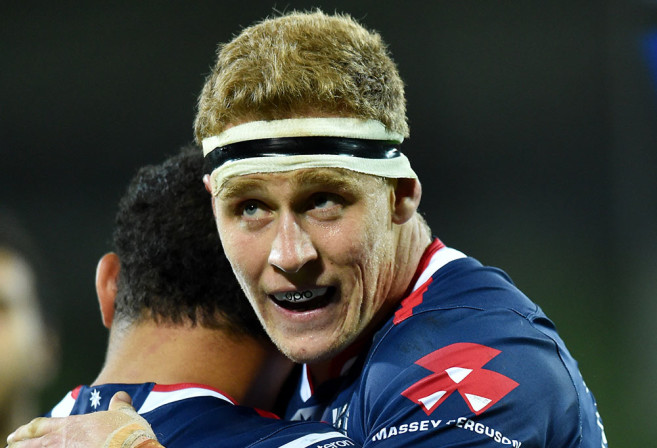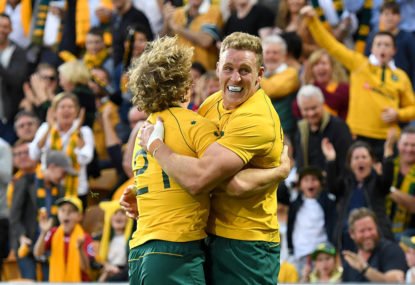The Kiwis, England and South Africa all have a very important advantage over Australia: they have enough talent to let them decide what a player’s best position is and give them support and development to improve.
Australia, meanwhile, lacks that talent and depth in every position. As a result, Australian coaches often try and find a way to get their most talented 15 on the field, regardless of whether it is the correct position for the player of if it unbalances the team.
This can result in players spending too much time bouncing between positions. It may be successful over the short term, but it is not good for the player’s long-term development as they become jacks of all trades and masters of none. James O’Connor, Adam Ashley-Cooper and even Kurtley Beale have been victims of this.
Nor, long term, is it good for the Wallabies.
On the other hand, because the Wallabies do not have enough talent it is a requirement, to a certain extent, that they get their best players on the field.
Even if Reece Hodge is not really a winger, he is a better player than an out and out winger like Henry Speight, and so deserves the No.14 jersey above Speight despite this.
Wallabies coaches need to strike a balance between playing players in their correct position for their development and also ensuring the Wallabies get enough talented players on the field at once to be competitive. It is an unenviable position to have.
Hodge’s strengths and weaknesses
Reece Hodge has a lot of strengths, as well as developing strengths, and relatively few weaknesses.
Hodge is fairly quick and has decent pace off the mark. He also runs some excellent lines even if he is not fleet-footed like James O’Connor. He’s a large bloke with decent power through contact, even if he does not have the truly elite power of a Stirling Mortlock or Ngani Laumape.
He has the ability to pass long and short off both sides accurately. However, he seems to take a fair while to throw his passes – he currently struggles when he is rushed for time and has to throw passes quickly. Presumably this will improve, however.
Hodge also has decent vision and playmaking abilities, again, when given time. He’s good under the high ball and a strong tackler, while his defensive positioning and decision making is strong and improving.

(AAP Image/Tracey Nearmy)
Hodge has by far the biggest boot in Australian rugby. However, like his passing, he struggles when rushed and pressed by the defence.
His two main weaknesses are the fact he struggles with passing and kicking when pressed for time and that he is a jack of all trades.
As described above he is fairly fast, has fairly good acceleration, is fairly powerful through contact, fairly good under the high ball and a fairly good passer with fairly good vision. He is not yet world-class at anything.
Hodge’s best position
Hodge lacks the out and out acceleration and pace to be a world-class winger long term. He also lacks the speed of passing, kicking and decision making to be a long-term fly-half.
He could make a decent inside centre. However, an inside centre can go one of three ways. Either they are a playmaking inside centre like Matt Giteau, they are a powerful one like Laumape or they are a fleet-footed one like Tim Horan.
Hodge doesn’t have the playmaking skills of Giteau, nor the power of Laumape or the fleet-footedness of Horan. I can foresee Hodge hitting the defensive line and either being driven back or only just getting over it, unlike Laumape, who is capable of getting over the advantage line on almost every occasion.
Hodge would be a decent inside centre, but we would never see the best of him.
He has the high-ball skills to be fullback, as well as the ability to counterattack powerfully and pass out to his wingers. He also has a huge boot, and will get the time to use it from fullback.
Unfortunately, his very strong defence is less useful at fullback than in the centres.
Hodge possesses the tackling ability to play outside centre. His defensive positioning is also strong and improving. He may not have the speed of a winger, but he has more than enough speed and acceleration to excel in the centres.
His speed is more useful at No.13. Also, while he does not possess the truly elite strength through contact to be a Laumape-style No.12, he has more than enough strength – especially when coupled with his speed – to make line breaks at No.13.
He would also benefit from the increased time and space to pass from No.13. He is not a selfish player whatsoever and so would be able and willing to distribute the ball to his outside backs in a way we have not had with Tevita Kuridrani or Adam Ashley-Cooper at No.13.
Unfortunately, his huge boot is less useful at 13.
What do the Wallabies need?
Australia develops a lot of good outside backs and fullbacks at present. In 2017 we have the choice of Israel Folau, Kurtley Beale, Dane Haylett-Petty, Karmichael Hunt and Tom Banks.
In terms of centres we have Tevita Kuridrani, Samu Kerevi, Karmichael Hunt and Kurtley Beale.
Hunt and Beale will likely not be options after 2019, and perhaps not Folau or Haylett-Petty either. Samu Kerevi will, but seems more like an inside centre due to his power through contact and ability to tackle front on, but average defensive positioning.
The Wallabies have a very good young prospect at No.15 in Tom Banks, but thus far no one is putting their hand up for No.13.
Hopefully Hodge is seen is a long-term No.13 and is allowed to play there at Super Rugby level, before being given a go there for the Wallabies. Like Mortlock, perhaps he will move in from the wing to No.13?






























































































